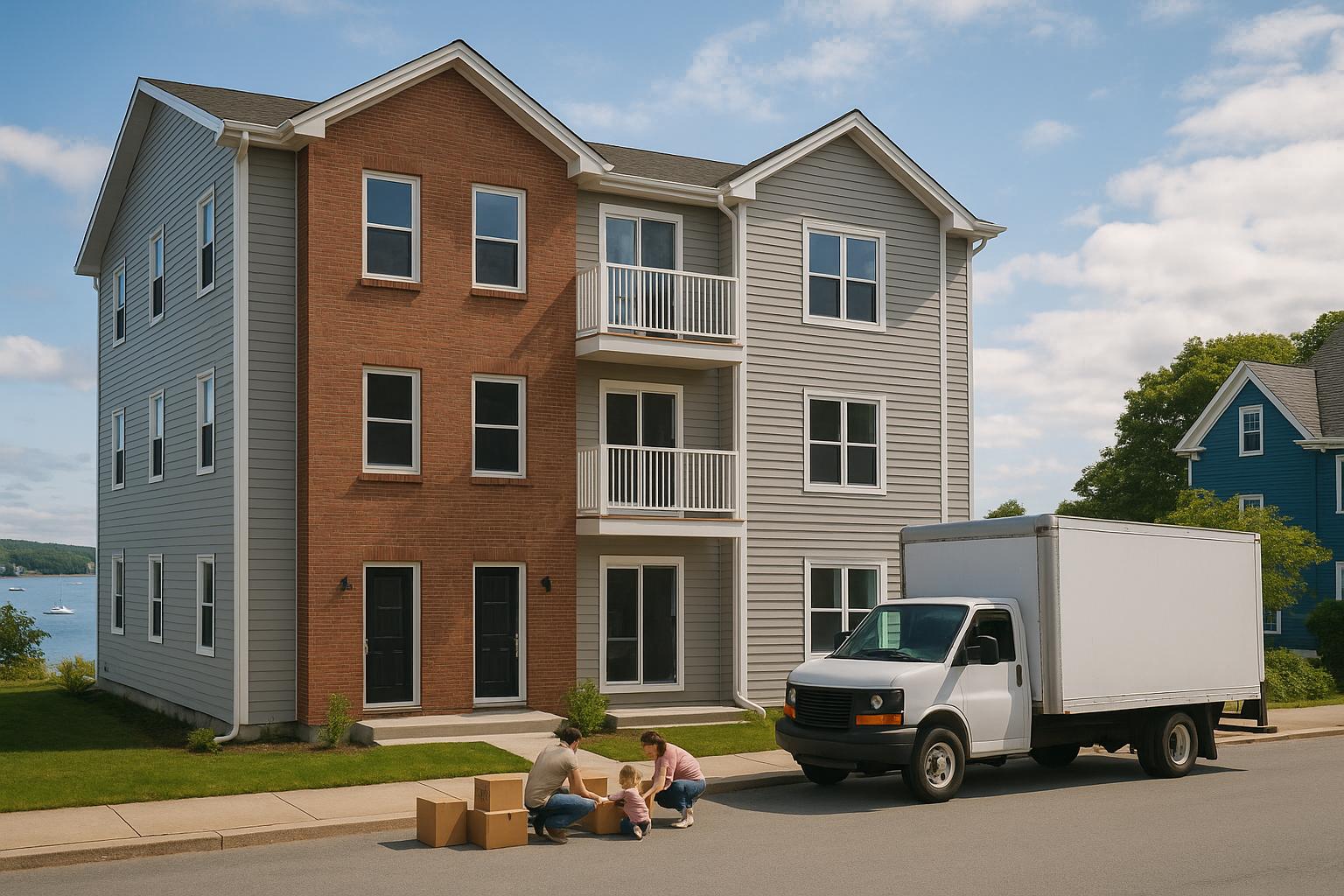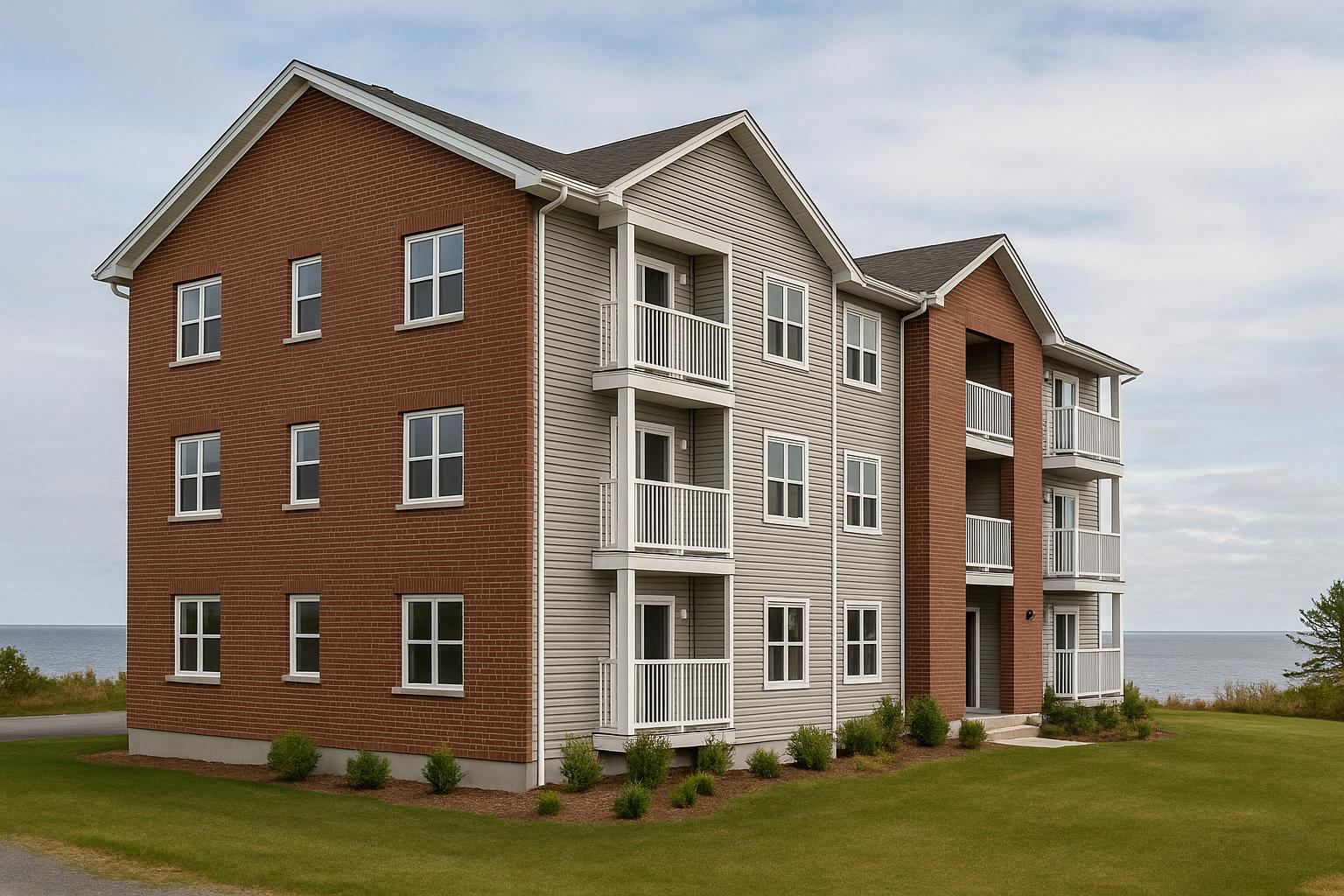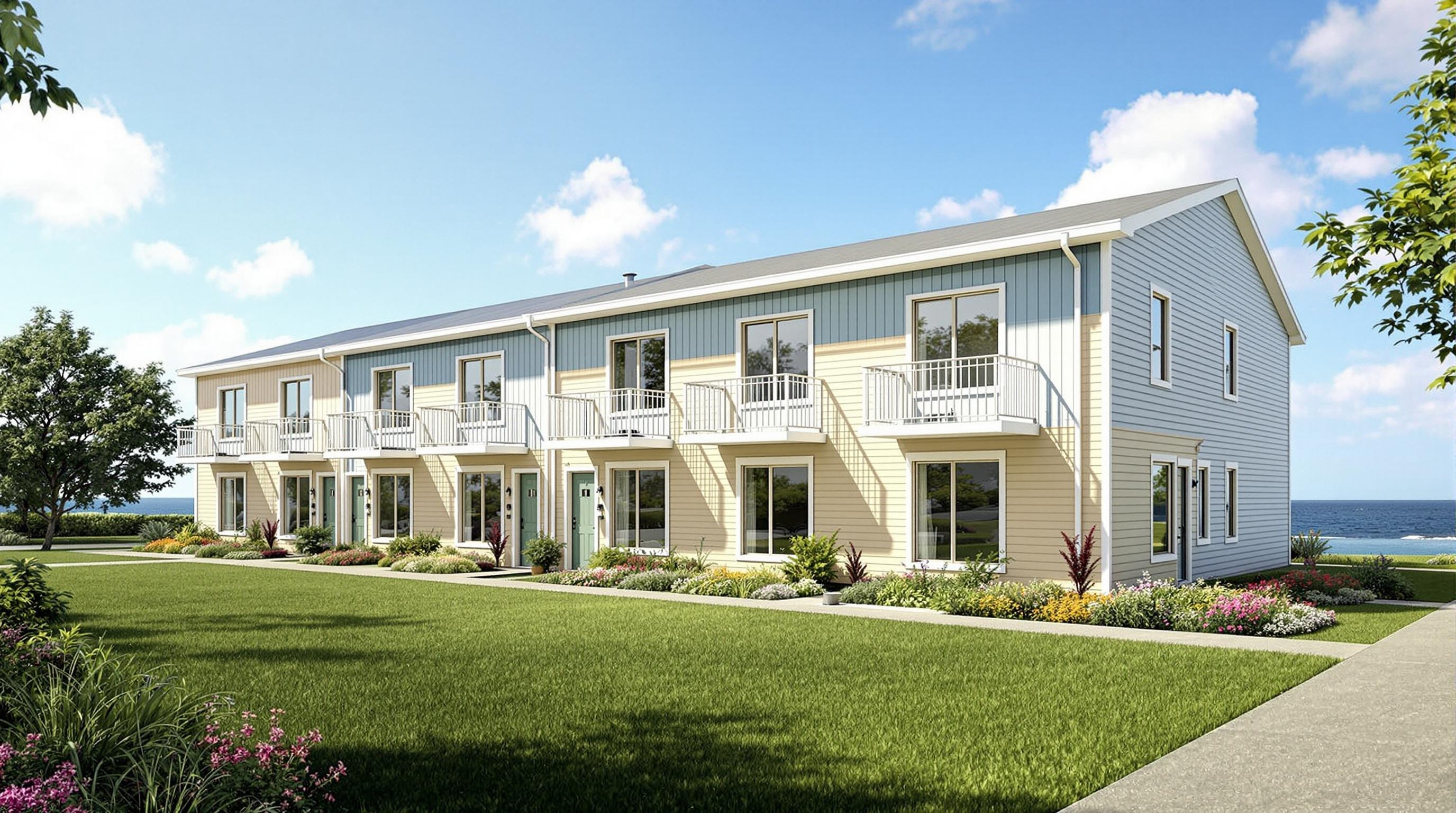Navigating Halifax's ER-3 zoning rules for multi-unit rental properties in the Agricola/Gottingen area can feel complex, especially when it comes to parking. Here's what you need to know:
- ER-3 Zoning Basics: Allows medium-density residential buildings (4–24 units) with specific rules on height, lot coverage, and parking.
- Parking Challenges: Narrow lots, heritage overlays, and tenant expectations make parking design tricky. Poor planning can lead to delays, budget issues, and tenant dissatisfaction.
- Solutions: Rear-yard parking, compact stalls, and efficient layouts help maximize space while meeting regulations. Halifax has also removed minimum parking requirements for ER-3 zones, offering more flexibility.
- Approval Tips: Include all zoning-required details (e.g., setbacks, snow storage, drainage) in site plans to avoid delays. Consider an integrated design-build approach to streamline the process and reduce costs.
Efficient parking design isn’t just about meeting regulations - it directly impacts tenant satisfaction, rental income, and project profitability.
Manual for Streets 3: Designing Parking
Parking Solutions for Multi-Unit ER-3 Properties
Managing parking in the Agricola/Gottingen area is all about finding the sweet spot between limited space, tenant expectations, and municipal regulations. A well-thought-out parking plan not only avoids expensive redesigns but also keeps tenants happy and more likely to stay.
Rear-Yard Parking and Efficient Layouts
One of the most effective ways to make the most of parking space in multi-unit properties is perpendicular parking layouts. By arranging parking spaces at a 90° angle to the driving aisles, you can increase the lot's capacity by about 20%[2]. This setup works particularly well in rear-yard parking designs.
For standard parking bays, the typical dimensions are 2.5 m by 5 m. When paired with a 6.5-metre aisle for smooth traffic flow, a 1,000 m² plot can fit anywhere from 30 to 35 vehicles while staying within compliance guidelines[1].
Another option to squeeze in more vehicles is compact parking stalls, which are ideal if the property regularly sees smaller cars[2]. These stalls can help maximize space without compromising usability.
Together, these layout strategies highlight the importance of a well-integrated approach to parking design for multi-unit ER-3 properties. By focusing on efficiency and smart planning, you can make the most of every square metre.
ER-3 Zoning Rules in Agricola/Gottingen
The ER-3 zoning regulations in Halifax's Agricola/Gottingen area combine municipal guidelines with neighbourhood-specific requirements. Ignoring these rules can lead to project delays and expensive redesigns. These regulations are essential for understanding the integrated parking solutions previously discussed.
Required Site Plan Elements
When developing multi-unit properties under ER-3 zoning, several critical factors must be addressed. Setback rules and lot coverage limits play a significant role in determining where parking and amenities can be placed. Front-yard parking is typically not allowed, as it disrupts the visual appeal of the streetscape.
Zoning rules also emphasize the need for properly screened garbage and recycling areas. These enclosures must blend visually with the main structure, enhancing the overall design. Height restrictions further ensure that new developments fit seamlessly into the neighbourhood's scale and character.
Heritage Overlay Requirements
For properties falling under heritage overlays, additional design considerations come into play. New constructions or alterations must respect the historic aesthetic of the area. This often involves choosing materials and design elements that align with traditional architectural styles. Projects in these zones are subject to a review process, requiring extra permits and detailed documentation to confirm that the design complements the area's historical context.
Specific design features, such as window and door placement, may face closer scrutiny to ensure they match the established look and feel of the neighbourhood.
Approval Process and Common Mistakes
The approval process for ER-3 site plans follows a structured sequence, but even minor errors can cause significant setbacks. Incomplete applications, such as those missing landscaping details, screening plans, or accurate parking calculations, often require resubmission.
To avoid delays, site plans must include all project components, such as bicycle parking, snow storage, and utility connections. Parking requirements are based on the number of dwelling units, with additional spaces often required for accessibility and visitor parking.
Stormwater management is another essential aspect. Larger developments or those with significant impervious surfaces must provide detailed drainage plans, often requiring input from a civil engineer. Early coordination with local utilities like Halifax Water and Nova Scotia Power is crucial, as their reviews can influence site layouts.
Adopting an integrated design-build approach can help navigate these challenges. By involving experienced professionals from the initial design phase through construction, this method minimizes delays and ensures compliance. A thorough zoning review at the outset simplifies parking design and keeps the project on track.
sbb-itb-16b8a48
Maximizing Land Use and Profits
Property owners in the Agricola/Gottingen area face an important decision when developing ER-3 multi-unit properties: stick with traditional construction methods, which often come with delays and cost overruns, or choose an integrated approach that improves both land use and financial outcomes. One key factor in maximizing returns for ER-3 developments is efficient parking design, which directly impacts the amount of buildable space. Let’s dive into how integrated design-build methods can deliver measurable benefits in efficiency and profitability.
Integrated Design-Build vs. Traditional Construction
Traditional construction typically involves hiring separate professionals for design, engineering, and construction. This fragmented approach often leads to coordination issues and delays, as each party works in isolation.
By contrast, an integrated design-build approach brings design and construction under a single contract, creating a unified team from the start [3]. This method allows for overlapping phases of design and construction, which can significantly shorten project timelines and speed up returns [3][4]. For instance, site preparation and foundation work can begin while other project details are still being finalized.
The design-build model ensures better coordination, reducing the risk of misunderstandings and aligning complex elements like parking layouts and building footprints [4]. Early collaboration between designers and builders often leads to creative solutions, such as shared driveways that optimize buildable space while meeting ER-3 zoning requirements. Builders can also contribute insights on materials, construction techniques, and energy-efficient options, further enhancing the project’s overall value.
Compared to traditional methods, integrated design-build eliminates much of the inefficiency caused by fragmented roles. This approach can lower unit costs by 1%–6% [3], shorten project timelines to about six months instead of the typical 8–18 months [3][4], and provide a single point of contact for smoother communication. These operational improvements directly impact both construction expenses and rental income potential, as detailed below.
Construction Costs and Returns for Property Owners
In general, construction costs for ER-3 units average around CA$160,000 per unit. For those aiming for higher energy efficiency or premium finishes, costs may be slightly higher. If you’re pursuing CMHC MLI Select financing, construction costs usually rise to about CA$200,000 per unit. However, this financing option offers a significant advantage: access to up to 95% financing with minimal upfront capital, allowing property owners to build more units without requiring additional funds.
Rental income in the Agricola/Gottingen area further strengthens the financial appeal. Well-designed 2-bedroom units in new ER-3 developments typically command monthly rents ranging from CA$1,950 to CA$2,100, ensuring solid annual returns.
The faster timelines associated with design-build projects also protect cash flow. By guaranteeing timely completion, this approach minimizes financial risks and keeps rental income on track.
Real Examples: Parking Solutions in ER-3 Projects
Looking at recent ER-3 projects in Halifax, we can see how thoughtful parking design addresses the challenges of urban development while meeting both regulatory and tenant needs.
Parking Solutions for Narrow Lots
In areas like Agricola and Gottingen, narrow lots often present unique challenges. However, policy updates under the Centre Plan have eliminated minimum parking requirements for ER-3 zones, offering property owners greater flexibility to tailor parking to their specific sites [6][7].
One effective approach has been rear-yard parking, accessible via narrow side driveways. This setup serves multiple units while maximizing the usable building area. Importantly, ER-3 zoning requires all parking to be located at the rear of the property and screened from neighbouring homes [7].
This strategy works particularly well for lots that take advantage of the increased lot coverage now permitted for smaller ER-3 properties - up to 60% in some cases [5]. By allowing more of the lot to be built upon, property owners can balance the need for parking with expanded living spaces.
Property owners who use integrated design-build methods report smoother outcomes. These teams coordinate parking layouts and building designs from the start, avoiding the disjointed results that can arise when design and construction are handled separately. The result? Parking solutions that feel intentional, optimize space, and meet both tenant needs and zoning rules.
Meeting Tenant Needs and Zoning Rules
Once space is used efficiently, the next challenge is ensuring parking designs align with tenant expectations and municipal regulations. Halifax's urban core projects show that the best parking solutions are those that are compliant, convenient, and secure.
A motion by Councillor Waye Mason in July 2023 emphasized the importance of thoughtful parking placement, alongside other measures like garbage screening and landscaping, to minimize impacts on neighbouring properties [5].
"My motion suggested allowing both secondary and backyard suites in ER zones, rather than allowing either/or which would raise the unit counts for ER1 from 2 to 3, and ER2 from 3 to 4, and allowing internal conversions in ER2 and ER3 zones to 5 units, and allowing modest increases to the building envelope to accommodate fire escapes/secondary egress."
- Waye Mason, Councillor, District 7 – Halifax South Downtown [5]
Recent projects, such as the four-storey wood frame buildings at Brewery Park near Almon and Agricola, showcase how parking can be seamlessly integrated into higher-density developments. These designs demonstrate a "gentle density" approach, maintaining a human-scale streetscape while accommodating more residents. Smart parking layouts in these projects ensure that urban growth remains both practical and liveable.
Key Points for Property Owners
When it comes to integrated parking designs, there are a few strategies that can help boost the profitability of your project, particularly for ER-3 developments in areas like Agricola/Gottingen.
A well-thought-out parking design can directly impact your profits. By customizing parking solutions to fit the specific needs of your project, you can make better use of your land and increase rental income without falling into the trap of generic, one-size-fits-all solutions.
Underground parking frees up valuable ground-level space for commercial units, residential areas, or even landscaping opportunities, making your project more versatile and appealing [8].
Providing abundant bicycle parking goes a long way toward tenant satisfaction. Beyond meeting the basic requirements, offering secure bike storage supports eco-friendly transportation and is a highly desirable feature, especially in transit-friendly areas like Agricola/Gottingen [8][9].
Push for reduced vehicle parking ratios. If your location is well-connected to public transit and close to local amenities, you might be able to justify fewer vehicle parking spaces. This aligns with municipal goals to reduce dependence on private cars [8][9].
Think of parking as more than just a necessity - make it a key part of your development plan.
FAQs
How do Halifax's updated ER-3 parking rules impact multi-unit property design and profitability?
Halifax has introduced updated ER-3 parking regulations, now requiring only one parking space for every three units. This adjustment provides property owners with greater flexibility and opens up opportunities to better utilize land. For example, it allows for the development of up to eight units per lot, which can boost rental income and increase property value.
By reducing parking requirements, construction costs decrease, and the permitting process becomes more streamlined. These changes not only help address Halifax's strong rental demand but also improve the financial outlook for multi-unit developments. In fact, potential annual returns on investment (ROI) for such projects could range from 12% to 20%.
What are the advantages of using a design-build approach for ER-3 projects in the Agricola/Gottingen area?
Using the design-build method for ER-3 developments in the Agricola and Gottingen area comes with several clear benefits. By combining both design and construction into a single contract, this approach simplifies project management, leading to smoother coordination and quicker completion times.
What sets this method apart is its emphasis on collaboration. By bringing all parties together early in the process, it reduces the chances of miscommunication and avoids unnecessary delays. It also helps keep costs in check and lowers risks by offering a single point of accountability throughout the project.
For property owners, this means they can make the most of their land while adhering to Halifax's zoning and parking regulations. The result? Projects that are efficient, compliant, and perfectly suited to this dynamic urban neighbourhood. Design-build is a practical choice for multi-unit developments in this thriving area.
What are the best strategies for meeting tenant needs and municipal parking regulations in Halifax's ER-3 zones?
To meet tenant needs and adhere to Halifax's ER-3 zoning rules, it's crucial to focus on smart parking designs that make the best use of available land while staying within local regulations. Prioritizing parking in rear or side yards, instead of the front, not only aligns with zoning guidelines but also improves the overall appearance of your property. Space-efficient options like tandem or shared parking can help fit more vehicles without taking up too much valuable space.
Make sure your plans comply with setback, landscaping, and screening requirements to stay within the rules and gain community approval. For added value, think ahead by incorporating amenities such as EV charging stations and bike storage, which are becoming increasingly popular with urban tenants. Careful planning not only boosts tenant satisfaction but also sets the foundation for long-term success.



